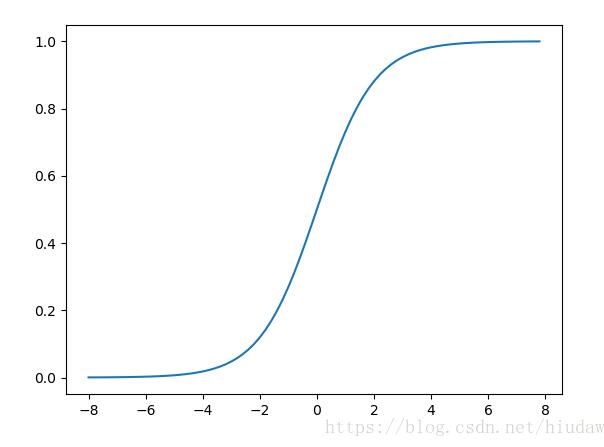我就废话不多说了,大家还是直接看代码吧~
|
1
2
3
4
5
6
7
8
9
10
11
12
13
14
15
|
import matplotlib.pyplot as pltimport numpy as np def sigmoid(x): # 直接返回sigmoid函数 return 1. / (1. + np.exp(-x)) def plot_sigmoid(): # param:起点,终点,间距 x = np.arange(-8, 8, 0.2) y = sigmoid(x) plt.plot(x, y) plt.show() if __name__ == '__main__': plot_sigmoid() |
如图:

补充知识:python:实现并绘制 sigmoid函数,tanh函数,ReLU函数,PReLU函数
如下所示:
|
1
2
3
4
5
6
7
8
9
10
11
12
13
14
15
16
17
18
19
20
21
22
23
24
25
26
27
28
29
30
31
32
33
34
35
36
37
38
39
40
41
42
43
44
45
46
47
48
49
50
51
52
53
54
55
56
57
58
59
60
61
62
63
64
65
66
67
68
69
70
71
72
73
74
75
76
77
78
79
80
81
82
83
84
85
86
87
88
89
90
91
92
93
94
95
96
97
|
# -*- coding:utf-8 -*-from matplotlib import pyplot as pltimport numpy as npimport mpl_toolkits.axisartist as axisartist def sigmoid(x): return 1. / (1 + np.exp(-x)) def tanh(x): return (np.exp(x) - np.exp(-x)) / (np.exp(x) + np.exp(-x)) def relu(x): return np.where(x<0,0,x) def prelu(x): return np.where(x<0,0.5*x,x) def plot_sigmoid(): x = np.arange(-10, 10, 0.1) y = sigmoid(x) fig = plt.figure() # ax = fig.add_subplot(111) ax = axisartist.Subplot(fig,111) ax.spines['top'].set_color('none') ax.spines['right'].set_color('none') # ax.spines['bottom'].set_color('none') # ax.spines['left'].set_color('none') ax.axis['bottom'].set_axisline_style("-|>",size=1.5) ax.spines['left'].set_position(('data', 0)) ax.plot(x, y) plt.xlim([-10.05, 10.05]) plt.ylim([-0.02, 1.02]) plt.tight_layout() plt.savefig("sigmoid.png") plt.show() def plot_tanh(): x = np.arange(-10, 10, 0.1) y = tanh(x) fig = plt.figure() ax = fig.add_subplot(111) ax.spines['top'].set_color('none') ax.spines['right'].set_color('none') # ax.spines['bottom'].set_color('none') # ax.spines['left'].set_color('none') ax.spines['left'].set_position(('data', 0)) ax.spines['bottom'].set_position(('data', 0)) ax.plot(x, y) plt.xlim([-10.05, 10.05]) plt.ylim([-1.02, 1.02]) ax.set_yticks([-1.0, -0.5, 0.5, 1.0]) ax.set_xticks([-10, -5, 5, 10]) plt.tight_layout() plt.savefig("tanh.png") plt.show() def plot_relu(): x = np.arange(-10, 10, 0.1) y = relu(x) fig = plt.figure() ax = fig.add_subplot(111) ax.spines['top'].set_color('none') ax.spines['right'].set_color('none') # ax.spines['bottom'].set_color('none') # ax.spines['left'].set_color('none') ax.spines['left'].set_position(('data', 0)) ax.plot(x, y) plt.xlim([-10.05, 10.05]) plt.ylim([0, 10.02]) ax.set_yticks([2, 4, 6, 8, 10]) plt.tight_layout() plt.savefig("relu.png") plt.show() def plot_prelu(): x = np.arange(-10, 10, 0.1) y = prelu(x) fig = plt.figure() ax = fig.add_subplot(111) ax.spines['top'].set_color('none') ax.spines['right'].set_color('none') # ax.spines['bottom'].set_color('none') # ax.spines['left'].set_color('none') ax.spines['left'].set_position(('data', 0)) ax.spines['bottom'].set_position(('data', 0)) ax.plot(x, y) plt.xticks([]) plt.yticks([]) plt.tight_layout() plt.savefig("prelu.png") plt.show() if __name__ == "__main__": plot_sigmoid() plot_tanh() plot_relu() plot_prelu() |
以上这篇Python3 用matplotlib绘制sigmoid函数的案例就是小编分享给大家的全部内容了,希望能给大家一个参考,也希望大家多多支持服务器之家。
原文链接:https://blog.csdn.net/hiudawn/article/details/79876726










